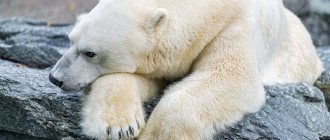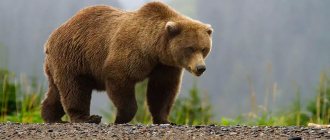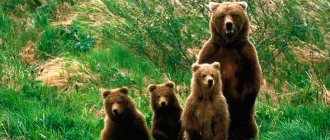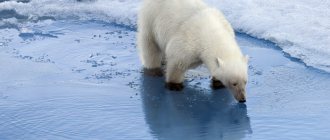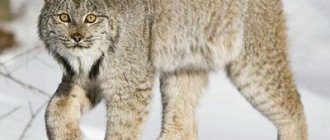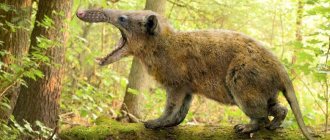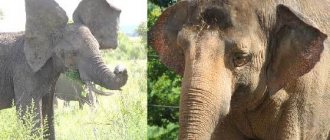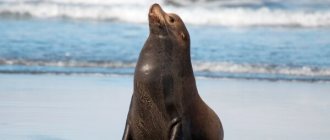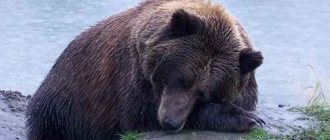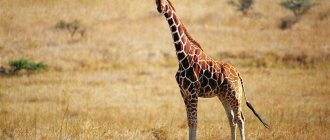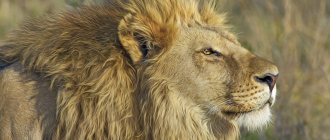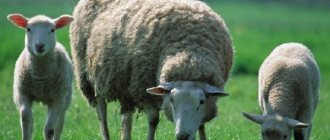Are all bears excellent swimmers and divers?
The clumsy, huge, club-footed brown bear is familiar to most of us from children's fairy tales.
Most people have this impression about this inhabitant of taiga forests for the rest of their lives. It turns out that this is not true at all. The brown bear is a very interesting animal. Despite his enormous size, he runs fast, can swim and climb trees. The bear not only knows how, but also loves to swim. Clubfoot especially likes this on a hot day. In water, a brown bear can cover a distance of up to 6 km. The bear swims with pleasure, but does not like to dive. When diving into the water, it leaves its head on the surface.
Polar bear This animal spends almost its entire life near the ocean. Therefore, he simply needs to be a good swimmer. It finds its food in the water. When in cold water, it reaches a speed of about 20 km/h. The polar bear dives if necessary. A polar bear dives into the ocean or sea no deeper than 2m. He can swim underwater. Before plunging into the depths of the water, this experienced diver folds his front paws over his head and dives. Once immersed in water, a bear can stay there for up to two minutes. It does not freeze in water because a thick layer of fat and water-repellent fur protect it from hypothermia. Under water, a bear's ears and nose close tightly, but its eyes are wide open, so it can catch its prey without difficulty. Most often, the bear hunts fish and seals this way. If the prey is sitting on an ice floe, then the bear dives into the water, quietly swims up to the ice floe, breaks it from below and grabs the animal, which is not aware of the danger. Zoo aquatic enclosures often use rings of wells to simulate underwater obstacles when catching prey.
Now you know which bears can dive and which ones can only swim.
Source
Methods of transportation
Despite the fact that the polar bear is born on land, it spends most of its time in the water, hunting sea life. Thanks to this, he got another name - “sea bear”. There was a case when one bear swam across the Bering Sea for 9 days without stopping to the nearest ice floe and covered a distance of 687 km.
The way this huge animal moves suggests that it is clumsy and slow-moving. But this opinion is wrong. The polar bear reaches swimming speeds of up to 4-5 km per hour. A large amount of fat under the skin allows the animal to easily float on the surface of the ocean, replacing the air cushion.
Despite the fact that the bear has a clumsy gait by nature, he runs, if necessary, quite deftly. Thus, the speed of a polar bear can be compared with that of a galloping horse. But they rarely use the body's resources to the maximum - due to the fact that they can quickly overheat.
How bears swim
Bears, these large and furry creatures, seem so clumsy to us that even the thought of their ability to swim seems incredible to us. However, bears are excellent swimmers, and their swimming can impress the best athletes. In this article we will talk in more detail about how bears swim.
Bear swimmer
Although in some zoos where there is a special pond, bears happily demonstrate their skills, most of all the bear loves to swim in nature, when the heat is monstrous. But it’s difficult to force a bear to dive; it always keeps its head above the water. Fishermen have often seen entire families of bears swimming across rivers to escape a forest fire.
Reasons for the decline in animal populations
Northern bears cannot survive without ice. With its help, the life cycle of animals is regulated, allowing them to reproduce, obtain food, raise young animals and move from place to place. Therefore, the melting of ice leads to the extinction of these beautiful and majestic inhabitants of the northern latitudes. As of 2008, the population of these animals was about 25 thousand individuals. And their numbers are declining primarily due to climate change.
People hunt these beauties for their magnificent warm fur, meat and fat. A small part of small bear cubs, when they are captured alive, end up in zoos and circuses. Meat and bear fat are eaten by residents of the Far North, but only dogs are fed with its liver. It is believed to be harmful and even poisonous. Eskimos sew boots from fur and use them to cover themselves in tents, but it is not suitable for sewing fur coats.
Polar bears also have their own holiday: International Polar Bear Day is celebrated on February 27.
How long can polar bears swim? Can they drown?
Many people say that polar bears are excellent swimmers. On the open sea they feel “like a fish in water.”
But to what extent are clubfooted people really “friendly” with the water element? After all, they are not marine mammals, but terrestrial ones.
Let's start with the fact that polar bears actually feel very confident in the water - they can swim for hours on end.
, without particularly straining.
Moreover, their maximum speed is about 8-10 km/h.
But how does it not freeze, the water is cold?
Yes, the water is cold.
But the polar bear has a significant counterargument in the form of a 10-centimeter layer of subcutaneous fat. And thick wool also protects well from the cold.
How does a polar bear manage to hold its massive carcass?
Firstly, he keeps himself afloat by moving his paws.
When swimming, the umka uses its front legs as oars, while its hind legs are elongated and serve as rudders.
Secondly, the bear’s hairs are hollow inside and “work” like tiny floats, making the bear more buoyant.
Where no man has gone before
The polar bear lives in the Far North. It is also known that the white giant can live where no person has yet gone. Travelers met him on the eastern coast of America, on Spitsbergen and other islands. In Lapland and Iceland, bears can be seen drifting on an ice floe.
The polar predator can get to other warm countries only if it is carried there on a block of ice.
Can a polar bear breathe underwater and other facts about the cute bear.
Polar bears can dive and swim for hours in icy water. How do they breathe on water? This question haunted me. I had to go to the library, yes, they still exist. and find out the answer to it.
Umka means strong!
The polar bear is the largest warm-blooded predator currently living on planet Earth. The height (length) of the beast can be more than three meters. And even when he stands on four legs his height is 1.5 meters
.
One and a half meters on all fours
, Karl! Massa Umki (so in Chukchi language
are called only large, huge adult male polar bears) can be up to 800 kg! Yes, this is just a colossus! I'm already afraid of him!
And this white “submarine” can easily swim and dive. Cruising speed of the white submarine is up to 3.5 knots
.
Sea knots! How else to catch a seal? Catch a sea hare
? Seal? But this is the usual prey of our hero. The photo above is a portrait of a sea hare!
We are not fish, we are not fish!
I'm not a fish, I'm a bear! - thinks every self-respecting Umka. And of course, he is not a fish, and like all mammals: seals and walruses, whales and dolphins, he cannot breathe underwater. Blondes and blondes have to develop lung capacity and train from their early bear childhood by diving further and further.
By the way, do you know if he goes to his den? No - look for the article on my channel. There are not many articles, you won’t have to scroll through them for a long time
! but all are interesting. That's interesting!
This kind of training allows bears to do without air, swimming underwater for 2 or even a little more than a minute
!
Try to hold your breath for this time; if you succeed, then you should think about a career as a pearl diver
. More about them in future articles!
Mating season
The period of puberty in female bears begins around the age of four, in males a little later. The mating season for polar bears falls in the warm spring months. The female's pregnancy lasts, like that of a human, 9 months. In the first year, usually no more than one cub appears. In the future, the female bear can give birth to two or three cubs at intervals of two to three years. Polar bears reproduce in a den dug in the snow or soil. Thanks to the thick layer of snow covering the mother bear’s home, the temperature in it is 10-20 degrees higher than on the surface.
Bear cubs are born bald and blind. But by one month their eyes open, and by two months their teeth begin to erupt. Despite the impressive body weight of the mother, a newborn polar bear cub weighs just over 500 grams. Such a small weight is due to the fact that during pregnancy female bears do not eat anything, just like after giving birth, which distinguishes them from other animals, which during this period intensively eat for themselves and for their children.
Males can be very aggressive, especially during the mating season. To win the right to mate, one often has to compete with other applicants. Females, on the contrary, do not fight among themselves and are friendly to each other. They can often coexist with other mother bears; sometimes they even take in orphaned cubs and feed them with their own milk, treating them as their own cubs.
Polar bear milk is very fatty and contains many nutrients. The cubs quickly get enough of it, and they gain a lot of weight. By two months, the cub's weight is 10 kg. Babies can feed with adults as early as five months, but the period of breastfeeding lasts up to 2-3 years. During this period, the cubs almost catch up with the mother in height.
Cubs can play with each other, fight, biting their opponents. In this way they prepare for adulthood, in which they will have to hunt and defend themselves.
How bears swim.
Bears, these large and furry creatures, seem so clumsy to us that even the thought of their ability to swim seems incredible to us. However, bears are excellent swimmers, and their swimming can impress the best athletes. And if people use composite pools for training, then bears are given the ability to perfectly float on water by nature.
Bear swimmer
Although in some zoos where there is a composite pool or a special reservoir, bears happily demonstrate their skills, most of all the bear loves to swim in nature, when the heat is monstrous. But it’s difficult to force a bear to dive; it always keeps its head above the water. Fishermen have often seen entire families of bears swimming across rivers to escape a forest fire.
The best swimmers among bears are polar bears, which hunt fish in cold water. They are capable of reaching high speeds - almost 25 km/h! This bear can also dive perfectly. Why doesn't a polar bear freeze in icy water? It has a very thick layer of fat that protects against the cold. And its fur completely repels water. The structure of the polar bear’s ears is also interesting: they are capable of closing. But the eyes are always wide open to see their prey under the thick muddy water. A polar bear must swim, otherwise it will get sick.
For this reason, in zoos where these representatives of the animal world live, bears are given the opportunity to hunt underwater. Special obstacles are arranged for them, and the animals are given meat as a reward for overcoming them. Bears need to hunt, otherwise they suffer and lose their skills and stop reproducing. Bears teach their cubs to swim at an early age: they all go out on the water together and the parents do something like a set of exercises with the children. When bears reach a certain age, they begin to swim on their own.
Source
Being fat is sometimes good for you!
These animals have 11 cm of fat under their skin. In cold weather conditions you cannot do without it. It warms the bear, and in case of food shortage it will help survive hunger and not die. The large paw area - about 30 cm - helps distribute the weight when the bear steps on the ice.
The feet of the paws are covered with small tubercles that look like knobs. Polar bears have fur between their toes, allowing them to move well on slippery surfaces. There are also membranes on the paws for better movement through the water.
Bears are solitary animals
Bears may be considered the most antisocial mammals in the world. Courtship between adult males and females is very brief, and after mating, the females go off to raise their young on their own for about three years and then mate again with the males. Adult bears are almost completely solitary, which is good news for tourists who happen upon a lone grizzly bear in the wild, but an unusual occurrence considering that most other carnivorous and omnivorous mammals (from wolves to pigs) congregate at least in small groups.
2. The polar bear is also called the northern bear or the polar bear, and the northern peoples call it Nanuk or Oshkui.
3. The polar bear is not only the largest land predator in the northern latitudes, but an intelligent and resourceful predator that has managed to adapt and survive in such a harsh polar climate.
4. The polar bear is the largest warm-blooded predator on the planet. The weight of a polar bear can reach 1,000 kg, and its length is 3.5 - 4 meters.
5. Previously, another subspecies of polar bear lived in the Arctic - the giant polar bear. It weighed 1,200 kg and reached a length of more than 4 meters.
6. Due to its habitat in remote places from human civilization - above the Arctic Circle, the polar bear maintains a larger range of its habitat than any other predator. But despite this, it is listed as a vulnerable species, as its population is only between 20,000 and 25,000 individuals worldwide.
7.The closest relative of the polar bear is the brown bear. Both species evolved from the same ancestor approximately 600 thousand years ago.
8.Brown and polar bears can interbreed and produce hybrids due to the fact that they are related species and had common ancestors.
9. A polar bear, giving birth to 1 to 3 cubs at a time, carries them for 8 months. The cubs are born in a den between November and December. And already at the end of March - beginning of April, the female with the cubs gets out of the den.
10. Polar bears are considered big clean people. These animals spend 15-20 minutes daily on hygiene procedures, while thoroughly cleaning themselves from any remaining dirt and food particles. This is very important for them, since contaminated bear fur loses its insulating properties.
11. Polar bears have never lived in Antarctica and Australia.
12. About 90% of all polar bears live in Alaska and America.
13. Due to the fact that the polar bear’s paws are equipped with membranes, according to the classification it belongs to marine mammals.
14. If a polar bear cannot catch food for more than 7 to 10 days, its metabolism slows down and it begins to burn its fat reserves until it finds food.
15. They are also very smart and resourceful. When hunting seals (their most common prey), polar bears use a wide range of dexterous techniques. It is believed that they even cover their black noses with their paws to avoid being seen in the snow.
16. Due to their exceptional biological structure, polar bears are unusually warm-blooded animals. Their body temperature never drops below 31 degrees Celsius. They sometimes even avoid running and other physical activities to avoid overheating.
17.Adult polar bears lead a solitary lifestyle, but friendly relationships can arise and be maintained between them.
18. The largest representatives of the polar bear population live in the Barents Sea, and the smallest in Spitsbergen.
19. Even though polar bears are usually born on land, they spend most of their time at sea. Their scientific name Ursus Maritimus means "sea bear".
20. The polar bear is an excellent swimmer and can often swim for several days. One bear swam continuously for 9 days in the cold Bering Sea, covering a distance of 687 kilometers to reach ice far from land. They typically swim at a speed of 10 kilometers per hour. The polar bear has webbed feet that help it swim.
21. Also, a record swim of more than 600 km was made by a bear who swam across the Bosphorus Sea from Alaska to the pack ice in search of food.
22. Despite their impressive size, polar bears can reach speeds of up to 40 km/h when running on land. But he cannot run at such speed for long, as he may overheat.
23.Bears have an excellent sense of smell. They can smell the scent of a seal that has climbed onto the ice at a distance of 32 kilometers.
24. Polar bears do not freeze; a thick subcutaneous layer of fat, 13 centimeters thick, helps them do this.
25. Female polar bears from the southern parts of the Arctic raise their cubs for 2 years, and females from the colder part care for their cubs for 3 years.
26. Polar bears are believed to have evolved from their common ancestor with brown bears approximately 5 million years ago. They have evolved unique features that help them survive in the very cold Arctic region.
27. Some researchers believe that the intelligence of polar bears may be as high as that of monkeys, thanks to their ingenious hunting methods, ingenuity and ability to change their behavior depending on changing environmental problems.
28.The heaviest polar bear ever recorded weighed a whopping 1,002 kilograms. It was a male shot in northwest Alaska in 1960.
29.The ability of polar bears to swim in icy water without their fur getting wet is explained by the fact that it is covered with fat. This ensures its water-repellent property.
30. Due to melting ice caps, scientists predict that two-thirds of the current population of these amazing animals will disappear by 2050.
31. The average life expectancy of polar bears in the wild is about 30 - 35 years.
32. A record for the life expectancy of a polar bear was recorded in captivity. The world's oldest bear lived for more than 45 years.
33. The female and male polar bear differ in weight. The weight of a male can reach 700 – 800 kg, and a female polar bear predominantly weighs 300 kg.
34.Polar bears often travel on drifting ice floes.
35.Brown bears dig dens in the ground, and white bears dig dens in the snow, and such a den usually has several rooms and even an exhaust hood.
36. The skin of a polar bear is black, this helps them retain heat.
37. Polar bears hibernate for the winter for 50-80 days, and then only pregnant females in order to produce offspring.
38. The female’s pregnancy lasts 230-240 days, after which tiny cubs weighing 400-750 grams are born.
39. Even though the two bear species have been separate species for a very long time, polar bears can still breed with brown bears and produce fertile grizzly-polar bear hybrids. This phenomenon occurs both in the wild and in captivity, but is very rare.
40. Although the polar bear is the world's largest predator, its adorable polar bear cubs are born even smaller than human babies. However, they are more intelligent because they quickly learn to remain absolutely still while their mothers hunt so as not to spook the prey.
41. Arctic foxes are typically preyed on by polar bears, but a strong friendship between the two animals has been documented in Canada. They played together and the giant bear even shared his food with his little fox friend.
42. Quite often they even have to go hungry and withstand strong winds and snow. However, polar bears are excellent fishers and find food under a thick layer of snow.
43. Polar bear hunting is successful only 2 percent of the time.
44. The tongue of polar bears is also highly pigmented and, partly due to the fact that a lot of blood flows to it, is sometimes even dark blue in color.
45. During periods of severe frost, when a polar bear goes to sleep, it covers its nose with its paw, which serves as the only heat generator.
46. The most characteristic feature of a polar bear is its completely white fur, but it is not quite what it seems. In fact, their hair follicles are transparent, hollow tubes. This allows their fur to reflect the light around them.
47.They even set aside an International Day for the polar bear - February 27th.
48. A polar bear comes to land almost dry after swimming.
49. The claws on the front paws of a polar bear are large compared to the hind paws.
50. Polar bears' fur can sometimes look a little yellowish or greenish. The yellowing is caused by age and dirt, while the greenish color is caused by algae that can grow in a polar bear's fur in unnaturally warm and humid conditions.
photo from the Internet
Why are they so fast?
jared lloyd/Getty Images
Despite their massive body, flat feet, and thick coat of fur that you might think would weigh them down, bears are surprisingly fast. Grizzly bears in particular have prominent shoulder blades covered in muscle mass that enable their forelimbs to run and dig ().
This muscular mound creates a distinctive hump on the upper back - the best way to distinguish a grizzly bear from a black bear.
Bears also have impressive claws that can reach more than 10 cm in length, which help them find footing on soft ground but can hinder their ability to run on hard surfaces such as asphalt. Because their forelimbs are shorter, they are strong enough to support more weight than their hind limbs.
This lopsided growth has long given the impression that animals cannot run downhill, but this myth has been repeatedly disproved. Only the 1937 Yellowstone Nature Records provides anecdotal evidence that the famous bear named Clubfoot actually ascended more slowly than he descended ().
4. Pinnipeds are the closest relatives of bears
Given the spread of so-called “bear dogs” millions of years ago, including a member of the amphicyon family, Amphicyon (see photo above), it can be assumed that modern bears are most closely related to canids. In fact, molecular analysis shows that bears' closest living relatives are pinnipeds, a family of marine mammals that includes seals and walruses. Both of these families of mammals descend from a common ancestor, ancestor, or “concestor,” who lived briefly during the Eocene epoch, about 40-50 million years ago, although the precise identification of the ancestor species remains a matter of debate.
